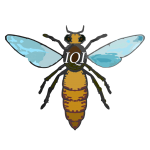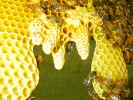NUCS IN A NUTSHELL
A nucleus hive, or nuc, is basically a starter colony of honey bees consisting of 5 frames . There are typically 2-3 frames of brood (eggs, larvae, and pupae),and frames of honey, nectar, and pollen, along with a queen and enough bees to cover the frames. It is highly recommended that you purchase your nucs from local sources within Illinois. Locally produced bees are more adapted to your area for disease and pest resistance, along with being adapted to the local environment (both climate and flora). In addition, you avoid any chance of obtaining bees with genetics from the Africanized Honey Bee.
All bees within the state of Illinois must be registered with the Illinois Dept. of Agriculture (within 10 days of locating your hive), and there is no charge for registration and the inspection service the IDOA provides.
Equipment and tools you will need to hive your new bees are: duct tape, utility knife,hive tool, gloves, veil, bee suit, a ten-frame hive, feeder, and pollenpatties. The duct tape is recommended for transporting your bees. It is not recommended that you transport them within your vehicle. It is best to secure them in your trunk or the bed of a truck. Transport them immediately to their new location.
STEP 1: Do not leave your nuc(s) unattended in your vehicle. Remove them and place in your bee yard in a shady and well-ventilated area.
STEP 2: Your nuc should be transferred into their new hive late in the day before it gets dark. Have your new hive set up at its permanent location with syrup feeder and pollen patties ready. Have your smoker lit; a little smoke may be necessary when first removing the nuc’s cover.
STEP 3: There are two methods for removing the frames from nucs to transfer into their new hive.
FIRST METHOD: If your bees are in a cardboard nuc, use a utility knife to carefully cut two top corners on one side of the box.Fold the cardboard down to expose the top and sides of the frames for easy removal. Using your hive tool, remove the frames in the order that they are in the nuc to the center of your new 10-frame hive. Fill the empty space with frames of foundation. Frames of nectar, pollen , and honey should be outside the brood frames. If the nuc frames are completely filled, you may place a frame of foundation between the brood frames and the food reserves.
SECOND METHOD: After removing the lid from the nuc with your hive tool, slowly and carefully pry the frames apart being careful not to harm any of the bees.Lift each nuc frame straight up and place in the order they are removed into the center of the new hive. Arrange as in STEP 1, and if using a frame feeder, insert it outside the brood nest frames. A frame of foundation may be placed between the brood and food reserve frames.
STEP 4: Begin feeding as soon as the bees are transferred to the new hive using a 50-50 sugar-water syrup. There are several syrup feeders on the market and your nuc provider can assist in choosing which model works best. Pollen substitute patties may also be given at this time, placing them on the tops of the brood frames. These should be replaced weekly since the Small Hive Beetle will want to lay its eggs in them if the opportunity arises. You may want to use a beetle trap to help control this pest.
STEP5: In about a week check your hive and start becoming familiar with the inner workings of a bee colony, especially the expansion process. As the brood nest expands, add more foundation frames between the brood and food reserves.
STEP 6: If all goes well and the bees fill out the first box a second box should be added. Bees will work upwards into the top box and begin filling out the frames. You can discontinue feeding when you see several frames filled with honey reserves or the bees stop taking syrup from the feeder. Never use honey or frames of pollen from an unknown source to feed your bees as you run the risk of introducing unwanted diseases/pests. If your bees fill the first two boxes and there is enough time before winter, a super may be added for honey reserves. There will need to be a sufficient quantity of sealed honey to get your colony through the winter.
Finally; your nuc provider can act as a mentor and assist you with recommendations for the proper management of your bees.
SOURCES: Nucs are best obtained from local producers. Go to the Producer’s Link on this website.
Nucs in a Nutshell was submitted by IQI Director Lonnie Langley.



